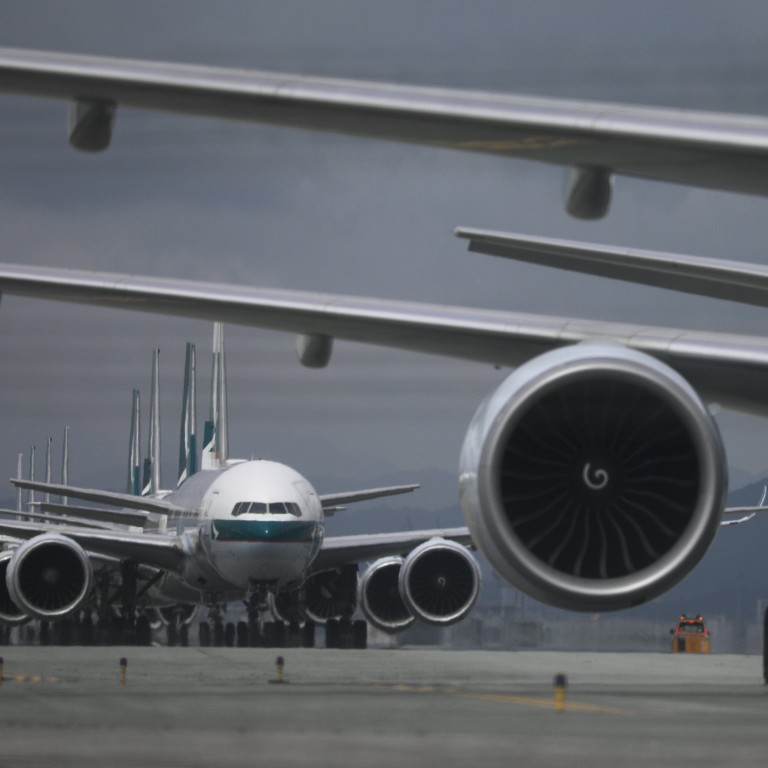
Cathay Pacific Airways warns of harsh outlook as Hong Kong’s flag carrier confirms record HK$9.9 billion loss in first half of 2020 caused by coronavirus crisis
- Hong Kong’s flag carrier has suffered a collapse in passenger demand during the global health crisis to post a HK$9.9 billion loss
- Cargo business generated more revenue than passenger operations, according to the financial results covering first six months of the year
Hong Kong’s flag carrier on Wednesday said a looming global recession and intensifying diplomatic tensions would lead to a “negative impact” on its operations.
Bosses described the first six months of 2020 as the most challenging in Cathay’s 73-year history. The outlook appeared to show little improvement, chairman Patrick Healy warned.
“The short-term future is going to be tough [and] extremely challenging. It is very difficult to say with certainty but I don’t think we are expecting the second half to be better than the first half at this point in time,” he said at a press conference.
The impact of Covid-19 on Cathay’s business and the global economy was “unprecedented”, the company said earlier in the day.
Previously the company reported a HK$1.34 billion net profit for the same period last year.
The airline’s cargo business generated more revenue than passenger operations in the first six months of this year, according to Wednesday’s announcement.

01:29
Hong Kong government to bail out Cathay Pacific with HK$30 billion in loans and direct stake
Cathay has yielded significant cost savings through capacity reductions, most staff taking pay cuts through unpaid leave, and the suspension of projects and non-essential spending while getting concessions and payment deferrals from suppliers, including on big-ticket items such as aircraft.
It has halved its cash burn to HK$1.5 billion a month, while operating a minimal number of flights.
Healy said the airline’s recently announced HK$39 billion recapitalisation plan and the current cost-saving measures combined would not be enough.
On possible job cuts in 2020, CEO Augustus Tang said: “It is inevitable we will need to make difficult decisions.” Many airlines around the world had already outlined significant job cuts or carried out mass redundancies.
Cathay Pacific is undergoing a sweeping restructure which is expected to include job cuts as well as a reduction in the number of planes and routes running once the pandemic is over, with the global recovery in air traffic believed to be four years away.
Healy reiterated that a return to pre-health crisis business levels was some time away. “We do not expect to see a meaningful recovery in our passenger business for some time to come,” the chairman said.
Despite the bleak financial performance, shares in Cathay Pacific soared 12 per cent to HK$5.88 on Wednesday, the highest one-day move since October 2008. The stock jumped on news that passengers could soon transit through Hong Kong to and from mainland China, lessening the impact of the coronavirus-related collapse in passenger travel.
As part of the HK$39 billion rescue plan unveiled in June, the Hong Kong administration invested HK$27.3 billion to prevent the carrier’s collapse, part of a trend of government intervention to prop up ailing airlines.
Cathay given permission to keep cutting schedule until March next year
Air travel is facing its most serious crisis in its history with the Covid-19 crisis forcing many governments to close borders to non-residents, including Hong Kong, which also ordered returnees to undergo quarantine.
Cathay offered a note of optimism over its air freight business, as the fifth largest cargo carrier in the world, saying the outlook remained “positive” heading into the peak season.
Hong Kong, Singapore on list of 10 airports with most parked jets
Luya You, transport analyst at Bocom International, said: “Given [Cathay’s results are] in line with expectations, what is critical to watch now is the restructuring plan.
“Looking forward, it’s difficult to estimate the scale of capacity and cost cuts without knowing Cathay’s concrete strategy for 2021 and beyond.”
Cathay’s airline revenues fell 48.3 per cent to HK$27.7 billion under its latest performance results.
For cargo there was a 10 per cent improvement to HK$12.7 billion but passenger revenues slumped more than two-thirds to HK$11 billion. Costs fell only 33.5 per cent, failing to come close to the sharp revenue decline.
But Cathay managed bigger cuts to operating costs over the six months compared with some of its Asian peers, with Singapore Airlines and Korean Air achieving 23.9 per cent and 33.3 per cent respectively.
Korean Air and Taiwan’s Eva Air, which are Cathay’s close competitors for air cargo, reported second quarter operating profits off the back of stronger freight demand.

